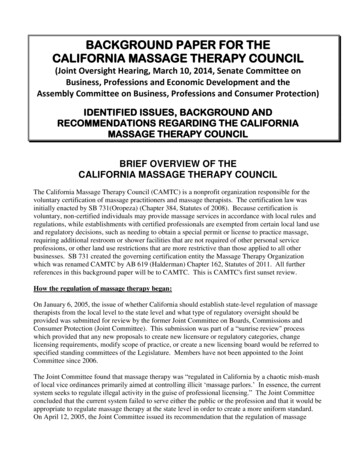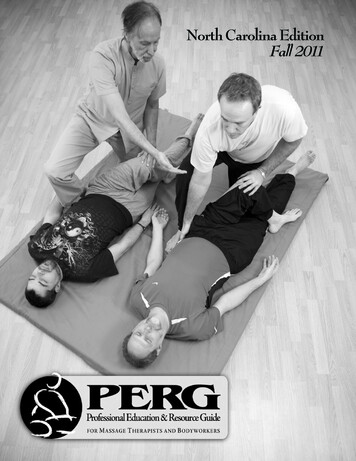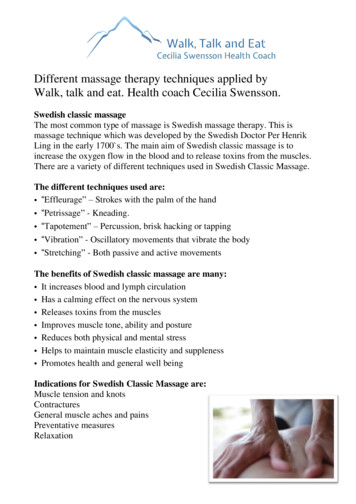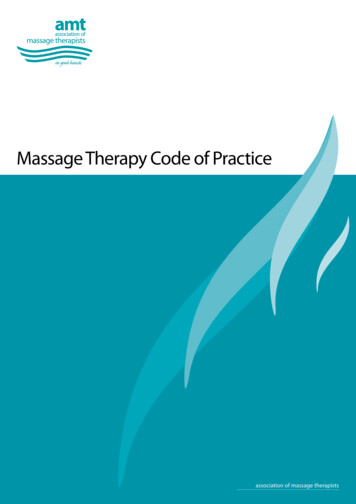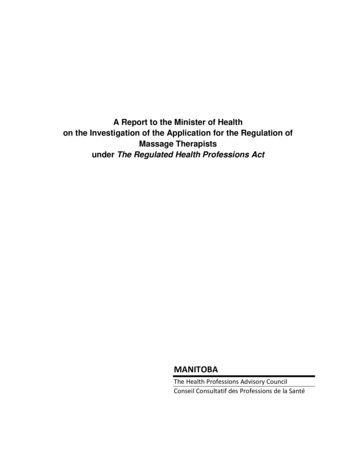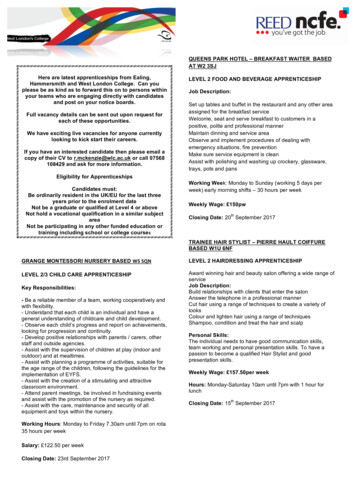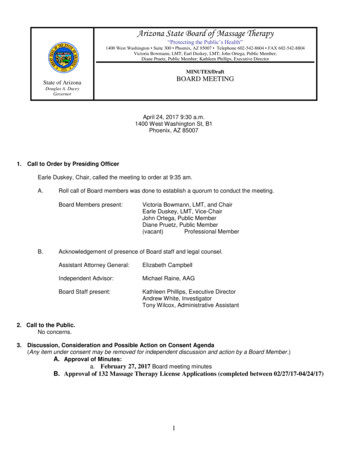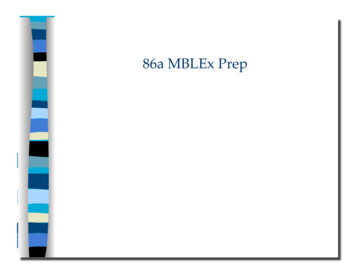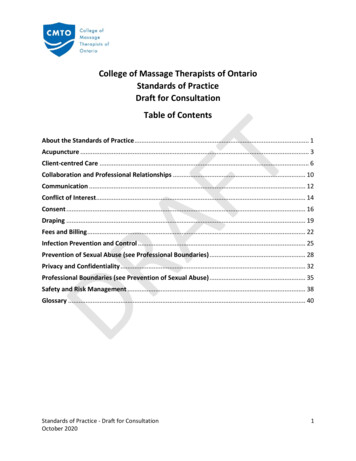
Transcription
College of Massage Therapists of OntarioStandards of PracticeDraft for ConsultationTable of ContentsAbout the Standards of Practice . 1AFTAcupuncture . 3Client-centred Care . 6Collaboration and Professional Relationships . 10Communication . 12Conflict of Interest. 14Consent . 16Draping . 19Fees and Billing . 22Infection Prevention and Control . 25Prevention of Sexual Abuse (see Professional Boundaries). 28DRPrivacy and Confidentiality . 32Professional Boundaries (see Prevention of Sexual Abuse) . 35Safety and Risk Management . 38Glossary . 40Standards of Practice - Draft for ConsultationOctober 20201
About the Standards of PracticeThe College of Massage Therapists of Ontario (CMTO) is the regulator established by theprovincial government to regulate the practice of Massage Therapy in Ontario and to governthe conduct of Massage Therapists (RMTs/MTs). CMTO’s mandate is to protect the public.Purpose of the Standards of PracticeAFTCMTO’s Standards of Practice play a key role in health regulation and public protection, bysetting the minimum requirements and expectations for all RMTs in Ontario, regardless of theirrole, job description or practice environment.The Standards of Practice can be used to: Outline what is expected of every RMT in Ontario;Inform other stakeholders about the expectations and requirements, including but notlimited to clients, employers, other health professionals, educators, students, examinationcandidates and applicants;Assess performance for CMTO’s Quality Assurance Program (STRiVE); andHelp guide decision-making when there is a complaint or concern about an RMT’s practice.DRIn addition to meeting the requirements of each Standard of Practice, RMTs must follow allrequirements outlined in legislation. RMTs may only practise within the Scope of Practice ofMassage Therapy as outlined in the Massage Therapy Act, 1991:“The practice of massage therapy is the assessment of the soft tissue and joints of the body andthe treatment and prevention of physical dysfunction and pain of the soft tissues and joints bymanipulation to develop, maintain, rehabilitate or augment physical function, or relieve pain.”How to Read the Standards of PracticeEach Standard of Practice is organized by the following headings: Registered Massage Therapist Outcome: Describes the expected outcome for which RMTsare responsible.Client Outcome: Describes what the client can expect from RMTs who are meeting theStandard of Practice.Requirements: Describes the minimum requirements that all RMTs must adhere to whenmeeting the Standard of Practice.Standards of Practice - Draft for ConsultationOctober 20201
References: Lists the relevant legislation(s).Resources and Guidance: Offers links to other practice resources that provide more detailon how to apply or implement the Standard of Practice. This section is intended for thereader who wants to learn more about a Standard of Practice or its requirements.Related Standards of Practice: Lists Standards of Practice that have overlapping or relevantmaterial.Related Career-Span Competencies (CSCs): Lists the CSCs of STRiVE - the Quality AssuranceProgram.Glossary: Key terms are defined in an accompanying glossary. The first time a key termappears in each Standard of Practice, it is bolded.AFT Additional Notes DR These Standards of Practice are outcomes-based and aim to provide the fewestprescriptive requirements as possible while protecting public safety. The content of theseStandards of Practice is determined by risk analysis for public protection.Standards of Practice are applicable in all practice settings, even those that may beconsidered non-clinical in nature. For example, a teacher modelling treatment whileteaching a student would be expected to meet the requirements set out in the Standards.RMTs may apply/implement the Standards of Practice in a way that is appropriate for theirpractice, as long as they first meet all the minimum requirements outlined in eachStandard of Practice.Contravening or failing to maintain a Standard of Practice is an act of professionalmisconduct under CMTO’s Professional Misconduct Regulation.Whenever applicable, the same requirements apply to paper or electronic documents orforms of communication, including but not limited to records, logs, receipts andcommunications. Relevant Legislation and RegulationRegulated Health Professions Act, 1991 (RHPA)Health Professions Procedural Code (Schedule 2 of the RHPA)Massage Therapy Act, 1991Health Care Consent Act, 1996 (HCCA)Personal Health Information Protection Act, 2004 (PHIPA)To access these and all other Ontario legislation, or if any of the above links are unavailable,please visit the Government of Ontario’s e-laws website to search alphabetically or by name ofthe statute.Standards of Practice - Draft for ConsultationOctober 20202
Standard of Practice:AcupunctureLast revised: DateImplementation: DateRegistered Massage Therapist OutcomeAFTAn authorized Registered Massage Therapist (RMT) 1 performs the controlled act ofacupuncture in compliance with relevant legislation and Standards of Practice.Client OutcomeThe client receives acupuncture treatment from a competent, authorized RMT who providessafe, effective and ethical treatment within the Scope of Practice of Massage Therapy.RequirementsThe RMT must:DR1. Have graduated from a Confirmed Acupuncture Education Program or have been grandparented by CMTO and have the required entry-level acupuncture practice competenciesas outlined in the Acupuncture Practice Competencies and Performance Indicators.2. Have applied for and been granted authorization from CMTO to practise acupuncture.3. Have the required professional liability insurance to practise acupuncture.4. Comply with CMTO’s annual declaration requirement (affirming the commitment to safepractice by maintaining the knowledge, skill and judgement to safely perform acupuncture)and currency requirement (declare number of acupuncture requirements over the pastyear).5. Be competent to safely provide acupuncture within the Scope of Practice of MassageTherapy.6. Practise within the Scope of Practice of Massage Therapy and follow all requirements ofCMTO’s Standards of Practice.7. Obtain the client’s informed consent (consent) in accordance with the Standard ofPractice: Consent. Consent must include a discussion with the client about:a. the nature of the treatment;1An RMT authorized to perform acupuncture has this notation on CMTO’s public register.Standards of Practice - Draft for ConsultationOctober 20203
the expected benefits;material risks and side effects;alternative courses of action;likely consequences of not having treatment; andtheir right to ask questions about the information provided and ability to withdrawtheir consent at any time.8. Drape in accordance with the Standard of Practice: Draping.9. Ensure the client’s ongoing comfort and safety, addressing any intended and unintendedeffects and outcomes as required.10. Comply with current Infection Prevention and Control (IPAC) measures and the Standardof Practice: Infection Prevention and Control, including:a. ensuring needles are sterile prior to use;b. storing and disposing of used needles safely;c. documenting and implementing needlestick injury protocols; andd. vigilance in maintaining high standards of cleanliness, skin disinfection technique,needling technique and careful anatomical considerations.11. When appropriate and with the client’s consent, refer the client to another RMT,healthcare professional or person whose expertise can best address the client’s needs,and document the referral in the client’s health record.ReferencesRegulated Health Professions Act, 1991 (RHPA)Health Care Consent Act, 1996 (HCCA)Professional misconduct in Section 26 of Ontario Regulation 544/94 under the MassageTherapy Act, 1991DR AFTb.c.d.e.f.Resources and GuidanceTo meet or exceed the Standard, please see the following: Code of EthicsConfirmed Acupuncture Education ProgramAcupuncture Practice Competencies and Performance IndicatorsRelated Standards of Practice Client-centred CareCommunicationConsentStandards of Practice - Draft for ConsultationOctober 20204
DrapingInfection Prevention and ControlSafety and Risk ManagementRelated Career-Span Competencies (CSCs)AFTAct with professional integrityApply the principles of sensitive practiceCommunicate effectivelyComply with legal requirementsFunction in a client-centred mannerMaintain a safe work environmentPractise in a manner consistent with current developments in the professionPractise in a self-reflective mannerUse an evidence-informed approach in your workWork within areas of personal knowledge and skillsDR Standards of Practice - Draft for ConsultationOctober 20205
Standard of Practice:Client-centred CareLast revised: DateImplementation: DateRegistered Massage Therapist OutcomeAFTThe Registered Massage Therapist (RMT) provides treatment that is focused on the bestinterests and unique needs of each individual client.Client OutcomeThe client receives safe, effective and ethical treatment from their RMT that respects theclient’s unique needs and health goals.RequirementsThe RMT must:DR1. Obtain the client’s informed consent (consent) in accordance with the Standard ofPractice: Consent before conducting an assessment or providing treatment. Consent mustinclude a discussion with the client about:a. the nature of the treatment;b. the expected benefits;c. material risks and side effects;d. alternative courses of action;e. likely consequences of not having treatment; andf. their right to ask questions about the information provided and ability to withdrawtheir consent at any time.2. Obtain the client’s written informed consent prior to every assessment and/or treatmentof sensitive areas including the upper inner thighs; chest wall muscles; and the breasts(which must not be touched except when treatment of the breast is requested by theclient for a clinically indicated reason such as following mastectomy or breast reduction).Written informed consent must also be obtained prior to treating the buttocks (glutealmuscles) but can be obtained once per treatment plan (then verbally prior to everytreatment).3. Assess the client, including obtaining health history, to determine their condition and ifMassage Therapy is indicated, using their knowledge, skills and professional judgement.Standards of Practice - Draft for ConsultationOctober 20206
DRAFT4. Develop a treatment plan for each client based on the assessment and client’s goals fortreatment, monitor the client’s response and modify treatment accordingly.5. Only treat, or attempt to treat, conditions within their competence and the Scope ofPractice of Massage Therapy.6. If they have dual registration, ensure the client understands when and in whatcircumstances they are receiving treatment from the RMT in their capacity as an RMT, andwhen they are receiving treatment which is outside the Scope of Practice of MassageTherapy and within the scope of another health profession in which they are regulated.7. When appropriate and with the client’s consent, refer the client to another RMT,healthcare professional or person whose expertise can best address the client’s needs.8. Provide fair and equitable access and consistent quality of treatment to all clients.9. Treat all clients with respect and dignity.10. Ensure the client’s continuing comfort and safety during the treatment, addressing anyintended and unintended effects and outcomes as required.11. Drape in accordance with the Standard of Practice: Draping.12. Promote the client’s involvement in their own health goals.13. Work with the client and others, as required, to plan and implement discharge fromtreatment.14. Only discontinue providing Massage Therapy services to a client if the discharge processhas been documented in the client’s file and:a. treatment is no longer beneficial or needed; orb. the client requests the discontinuation; orc. alternative services are arranged; ord. the client is abusive; ore. there is real or perceived threat to the RMT; orf. the client is given reasonable opportunity to arrange alternative services.15. Never abuse a client; this includes, but is not limited to, verbal, physical, psychological,emotional, sexual or financial abuse.16. Never have a sexual relationship with a client. This is sexual abuse. As it pertains to sexualabuse, a client will meet the definition of “client” for one year after they ceased to be theRMT’s client. That is, an RMT may not enter into a sexual relationship with a client for aperiod of one year after the client ceased to be a client. Additionally, it might never beethically appropriate to have a sexual relationship with a person who was previously aclient, regardless of the passage of time, due to power dynamics, the disclosing of healthinformation or other reasons. Even if this might not constitute “sexual abuse” within thedefinition in the legislation, it could still be professional misconduct.17. At the client’s request, securely transfer copies of the client’s health record to anotherRMT or other healthcare professional.18. Upon resignation, or closure of a clinic, refer the client to another RMT, healthcareprofessional or person whose expertise can best address the client’s needs; and takeStandards of Practice - Draft for ConsultationOctober 20207
necessary actions to ensure client health records are properly retained, transferred anddisposed of.References Health Care Consent Act, 1996 (HCCA)Massage Therapy Act, 1991Professional misconduct in Section 26 of Ontario Regulation 544/94 under the MassageTherapy Act, 1991AFTResources and GuidanceTo meet or exceed the Standard, please see the following: Policy: Zero ToleranceCode of EthicsRelated Standards of PracticeConsentCommunicationDrapingPrevention of Sexual AbuseProfessional BoundariesDR Related Career-Span Competencies (CSCs) Act with professional integrityApply the principles of sensitive practiceCommunicate effectivelyComply with legal requirementsFunction in a client-centred mannerInteract effectively with other professionalsMaintain a safe work environmentMaintain comprehensive recordsMaintain personal wellness consistent with the needs of practiceManage time and resources effectivelyPractise in a manner consistent with current developments in the professionPractise in a self-reflective mannerStandards of Practice - Draft for ConsultationOctober 20208
Treat others respectfullyUse an evidence-informed approach in your workWork within areas of personal knowledge and skillsDRAFT Standards of Practice - Draft for ConsultationOctober 20209
Standard of Practice:Collaboration and Professional RelationshipsLast revised: DateImplementation: DateRegistered Massage Therapist OutcomeAFTThe Registered Massage Therapist (RMT) practises in collaboration with clients, otherhealthcare professionals and others involved in the client’s care to provide safe, effective andethical treatment.Client OutcomeThe client understands that the RMT will work with others as required to provide the besttreatment to meet the needs of the client.RequirementsDRWhen working in collaboration with other healthcare professionals and others involved in aclient’s care, the RMT must:1. Take reasonable steps to ensure every client’s Massage Therapy treatment plan aligns withthe treatment plans of other healthcare professionals.2. Document collaboration and professional relationships in a client’s health record,including:a. reports received for examinations, tests, consultations or treatments; andb. the details of every referral made.3. Allow another healthcare professional who is providing or assisting in providing healthcareto a client access to the client’s health record where such access is reasonably necessaryfor the provision of healthcare, unless the client has expressly instructed the RMT not toprovide such access.4. Work to resolve any problems or conflicts that may arise between those involved in theclient’s care that could interfere with the delivery of safe, effective and ethical care.Document these concerns and the steps taken to resolve them.5. Refer the client to another RMT, healthcare professional or person whose expertise canbest address the client’s needs (when appropriate and with the client’s consent).ReferencesStandards of Practice - Draft for ConsultationOctober 202010
Ontario Regulation 544/94 under the Massage Therapy Act, 1991Professional misconduct in Section 26 of Ontario Regulation 544/94 under the MassageTherapy Act, 1991Resources and GuidanceTo meet or exceed the Standard, please see the following:Code of Ethics“A National Interprofessional Competency Framework.”AFT Related Standards of Practice Client-centred CareCommunicationConsentPrivacy and ConfidentialityRelated Career-Span Competencies (CSCs)Act with professional integrityCommunicate effectivelyFunction in a client-centred mannerInteract effectively with other professionalsTreat others respectfullyWork within areas of personal knowledge and skillsDR Standards of Practice - Draft for ConsultationOctober 202011
Standard of Practice:CommunicationLast revised: DateImplementation: DateRegistered Massage Therapist OutcomeAFTThe Registered Massage Therapist (RMT) clearly provides the client with the informationrequired to make informed decisions about their health and communicates in a professionalmanner.Client OutcomeThe client receives the information needed to make an informed decision about their MassageTherapy treatment and be given the opportunity to ask questions of their RMT.RequirementsThe RMT must:DR1. Obtain the client’s informed consent (consent) in accordance with the Standard ofPractice: Consent prior to assessment and/or treatment. Consent must include a discussionwith the client about:a. the nature of the treatment;b. the expected benefits;c. material risks and side effects;d. alternative courses of action;e. likely consequences of not having treatment; andf. their right to ask questions about the information provided and ability to withdrawtheir consent at any time.2. Use effective communication including plain language and active listening to accuratelytransmit information about Massage Therapy treatment.3. Adapt communication according to clients’ understanding and needs.4. Ensure that all forms of communication (spoken; written, including paper and electronic;and social media) are respectful, ethical and professional and that client privacy andconfidentiality is maintained at all times.Standards of Practice - Draft for ConsultationOctober 202012
References Health Care Consent Act, 1996 (HCCA)Personal Health Information Protection Act, 2004 (PHIPA)Resources and GuidanceTo meet or exceed the Standard, please see the following:Code of EthicsAFT Related Standards of PracticeAcupunctureClient-centred CareCollaboration and Professional RelationshipsConsentDrapingFees and BillingInfection Prevention and ControlPrevention of Sexual AbusePrivacy and ConfidentialityProfessional BoundariesSafety and Risk ManagementDR Related Career-Span Competencies (CSCs) Act with professional integrityApply the principles of sensitive practiceCommunicate effectivelyComply with legal requirementsFunction in a client-centred mannerInteract effectively with other professionalsMaintain comprehensive recordsTreat others respectfullyStandards of Practice - Draft for ConsultationOctober 202013
Standard of Practice:Conflict of InterestLast revised: DateImplementation: DateRegistered Massage Therapist OutcomeAFTThe Registered Massage Therapist (RMT) avoids any potential, real or perceived personal orfinancial conflict of interest. If the conflict of interest cannot be avoided, it must be managedand disclosed to the client.Client OutcomeThe client receives treatment that is solely in the best interest of the client and notcompromised by any potential, real or perceived personal or financial interest.RequirementsAn RMT must not practise while in a conflict of interest, including but not limited to:DR1. Providing or receiving a monetary or other benefit for referring a client to or from anotherperson or business (for example, a referral fee).2. Recommending a product or service in which the RMT has a personal or financial interestwithout first disclosing this interest and advising the client that they may obtain a suitablealternative product or service elsewhere. Document this discussion in the client healthrecord.3. Sharing professional revenue, fees or income with someone who is not a regulated healthprofessional in Ontario, unless the fee-sharing is done in accordance with a writtenagreement stating that the RMT maintains responsibility for all professional aspects oftheir practice, including record keeping and billing.4. Participating in a rental agreement that is based on business referred between the tenantand landlord.References Professional misconduct in Section 26 of Ontario Regulation 544/94 under the MassageTherapy Act, 1991Standards of Practice - Draft for ConsultationOctober 202014
Resources and GuidanceTo meet or exceed the Standard, please see the following: Conflict of Interest GuidelineCode of Ethics ConsentAFTRelated Standards of PracticeRelated Career-Span Competencies (CSCs)Act with professional integrityComply with legal requirementsFunction in a client-centred mannerDR Standards of Practice - Draft for ConsultationOctober 202015
Standard of Practice:ConsentLast revised: DateImplementation: DateRegistered Massage Therapist OutcomeAFTThe Registered Massage Therapist (RMT) obtains informed consent (consent) from clients ortheir substitute decision-makers prior to and throughout assessment and treatment.Client OutcomeThe client receives the information they need to make an informed decision about theirMassage Therapy treatment and is given the opportunity to ask questions of their RMT.Assessment and/or treatment only begins after the client has given the RMT consent. The clientis aware they can withdraw their consent at any time.RequirementsDR1. Before conducting an assessment or providing treatment, the RMT must obtain theclient’s consent. Consent must include a discussion with the client about:a. the nature of the treatment;b. the expected benefits;c. material risks and side effects;d. alternative courses of action;e. likely consequences of not having treatment; andf. their right to ask questions about the information provided and that assessment ortreatment will be stopped or modified at any time at their request.2. If the RMT does not have sufficient information about the risks, benefits andcontraindications of a modality or product, including topical products and lubricants,then consent cannot be obtained and the modality or product must not be used orapplied during the treatment.3. The RMT obtains the client’s written informed consent prior to every assessment and/ortreatment of sensitive areas including the upper inner thighs; chest wall muscles; andthe breasts (which must not be touched except when treatment of the breast isrequested by the client for a clinically indicated reason such as following mastectomy orbreast reduction). Written informed consent must also be obtained prior to treating theStandards of Practice - Draft for ConsultationOctober 202016
5.6.7.References AFT4.buttocks (gluteal muscles) but can be obtained once per treatment plan (then verballyprior to every treatment).Consent must relate to the assessment and/or treatment being proposed, be voluntaryand not obtained through misrepresentation or fraud.The client who is providing consent must be capable. If the client is incapable, then asubstitute decision-maker can provide consent on behalf of the client. If a client isincapable and no substitute decision-maker is present, RMTs must refuse to providetreatment.The RMT must verify client consent throughout assessment and treatment.RMTs must document consent conversations in the client health record within 24 hoursof the assessment or treatment. When the RMT obtains written consent for treatmentof sensitive areas, it must also be kept in the client health record.Health Care Consent Act, 1996 (HCCA)Ontario Regulation 544/94 under the Massage Therapy Act, 1991Professional misconduct in Section 26 of Ontario Regulation 544/94 under the MassageTherapy Act, 1991Personal Health Information Protection, 2004 (PHIPA)DRResources and GuidanceTo meet or exceed the Standard, please see the following: Practice Resource: CannabisCode of EthicsRelated Standards of Practice Client-centred CareCommunicationDrapingPrevention of Sexual AbuseProfessional BoundariesRelated Career-Span Competencies (CSCs) Act with professional integrityApply the principles of sensitive practiceStandards of Practice - Draft for ConsultationOctober 202017
Communicate effectivelyComply with legal requirementsFunction in a client-centred mannerMaintain comprehensive recordsDRAFT Standards of Practice - Draft for ConsultationOctober 202018
Standard of Practice:DrapingLast revised: DateImplementation: DateRegistered Massage Therapist OutcomeAFTThe Registered Massage Therapist (RMT) drapes clients effectively to protect client privacy andsafety and to maintain appropriate boundaries.Client OutcomeThe client is draped effectively to maintain appropriate boundaries and help prevent boundarycrossings and boundary violations.RequirementsDRThe RMT must:1. Obtain the client’s informed consent (consent) in accordance with the Standard ofPractice: Consent regarding draping before conducting an assessment and/or treatment.Consent must include a discussion with the client about:a. the nature of the treatment;b. the expected benefits;c. material risks and side effects;d. alternative courses of action;e. likely consequences of not having treatment; andf. their right to ask questions about the information provided and ability towithdraw their consent at any time.2. Explain to the client clearly what part of the body the RMT intends to assess or treat,and whether the touch will be directly on skin or through a cloth barrier (for example, asheet or the client’s clothing).3. Discuss with the client how sensitive areas will be draped to establish and protectboundaries throughout the treatment.4. Explain to the client how to best prepare for assessment and/or treatment, includingoptions to remove clothing or remain clothed and how to position themselves.5. Continuously monitor the client for change in consent and comfort with drapingthroughout treatment.Standards of Practice - Draft for ConsultationOctober 202019
ReferencesProfessional misconduct in Section 26 of Ontario Regulation 544/94 under the MassageTherapy Act, 1991DR AFT6. Drape securely to set clear physical boundaries that separate the areas being treatedand/or assessed and areas of the body where no touch will be applied.7. Drape to prevent visual exposure of any areas of the client’s body that are not beingtreated and/or assessed (except for the face and the head).8. Adjust draping throughout assessment and/or treatment to ensure that only the area ofthe body that is actively receiving assessment and/or treatment is uncovered, except forthe face and the head.9. Confirm consent immediately before undraping for bilateral assessments and/ortreatment.10. Only at the client’s request, uncover areas of the client’s body that the RMT is notactively assessing and/or treating for the client’s comfort (such as for temperatureregulation), except for a sensitive area which may only be exposed if the RMT is treatingand/or assessing that area and the client has requested treatment of the sensitive areaand provided written consent.11. Never expose the client’s genital area or gluteal cleft. Ensure that drape boundariesproperly protect the client from exposure of the genital area and the gluteal cleftwithout exception.12. Never reach underneath the draping.Resources and Guidance Code of EthicsPolicy: Zero ToleranceRelated Standards of Practice AcupunctureClient-centred CareCommunicationConsentPrevention of Sexual AbuseProfessional BoundariesSafety and Risk ManagementStandards of Practice - Draft for ConsultationOctober 202020
Related Career-Span Competencies (CSCs)AFTAct with personal integrityApply t
5. Be competent to safely provide acupuncture within the Scope of Practice of Massage Therapy. 6. Practise within the Scope of Practice of Massage Therapy and follow all requirements of CMTO's Standards of Practice. 7. Obtain the client's informed consent (consent) in accordance with the Standard of Practice: Consent.
